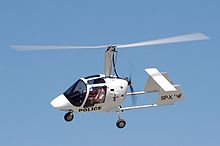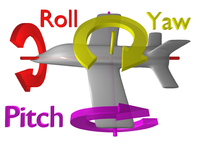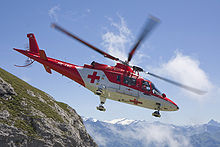
Aircraft
About this schools Wikipedia selection
This content from Wikipedia has been selected by SOS Children for suitability in schools around the world. See http://www.soschildren.org/sponsor-a-child to find out about child sponsorship.

An aircraft is a machine that is able to fly by gaining support from the air, or, in general, the atmosphere of a planet. It counters the force of gravity by using either static lift or by using the dynamic lift of an airfoil, or in a few cases the downward thrust from jet engines.
The human activity that surrounds aircraft is called aviation. Crewed aircraft are flown by an onboard pilot, but unmanned aerial vehicles may be remotely controlled or self-controlled by onboard computers. Aircraft may be classified by different criteria, such as lift type, propulsion, usage, and others.
History
Flying model craft and stories of manned flight go back many centuries, however the first manned ascent – and safe descent – in modern times took place by hot-air balloon in the 18th century. Each of the two World Wars led to great technical advances. Consequently the history of aircraft can be divided into five eras:
- Pioneers of flight, from the earliest experiments to 1913.
- First World War, 1914 to 1918.
- Inter-war, sometimes called the Golden Age, 1919 to 1938.
- Second World War, 1939 to 1945.
- Postwar era, also called the jet age, 1946 to the present day.
Methods of lift
Lighter than air – aerostats
Aerostats use buoyancy to float in the air in much the same way that ships float on the water. They are characterized by one or more large gasbags or canopies, filled with a relatively low-density gas such as helium, hydrogen, or hot air, which is less dense than the surrounding air. When the weight of this is added to the weight of the aircraft structure, it adds up to the same weight as the air that the craft displaces.
Small hot-air balloons called sky lanterns date back to the 3rd century BC, and were only the second type of aircraft to fly, the first being kites.
A balloon was originally any aerostat, while the term airship was used for large, powered aircraft designs – usually fixed-wing – though none had yet been built. The advent of powered balloons, called dirigible balloons, and later of rigid hulls allowing a great increase in size, began to change the way these words were used. Huge powered aerostats, characterized by a rigid outer framework and separate aerodynamic skin surrounding the gas bags, were produced, the Zeppelins being the largest and most famous. There were still no fixed-wing aircraft or non-rigid balloons large enough to be called airships, so "airship" came to be synonymous with these aircraft. Then several accidents, such as the Hindenburg disaster in 1937, led to the demise of these airships. Nowadays a "balloon" is an unpowered aerostat, whilst an "airship" is a powered one.
A powered, steerable aerostat is called a dirigible. Sometimes this term is applied only to non-rigid balloons, and sometimes dirigible balloon is regarded as the definition of an airship (which may then be rigid or non-rigid). Non-rigid dirigibles are characterized by a moderately aerodynamic gasbag with stabilizing fins at the back. These soon became known as blimps. During the Second World War, this shape was widely adopted for tethered balloons; in windy weather, this both reduces the strain on the tether and stabilizes the balloon. The nickname blimp was adopted along with the shape. In modern times, any small dirigible or airship is called a blimp, though a blimp may be unpowered as well as powered.
Heavier than air – aerodynes
Heavier-than-air aircraft must find some way to push air or gas downwards, so that a reaction occurs (by Newton's laws of motion) to push the aircraft upwards. This dynamic movement through the air is the origin of the term aerodyne. There are two ways to produce dynamic upthrust: aerodynamic lift, and powered lift in the form of engine thrust.
Aerodynamic lift involving wings is the most common, with fixed-wing aircraft being kept in the air by the forward movement of wings, and rotorcraft by spinning wing-shaped rotors sometimes called rotary wings. A wing is a flat, horizontal surface, usually shaped in cross-section as an aerofoil. To fly, air must flow over the wing and generate lift. A flexible wing is a wing made of fabric or thin sheet material, often stretched over a rigid frame. A kite is tethered to the ground and relies on the speed of the wind over its wings, which may be flexible or rigid, fixed, or rotary.
With powered lift, the aircraft directs its engine thrust vertically downward. V/STOL aircraft, such as the Harrier Jump Jet and F-35B take off and land vertically using powered lift and transfer to aerodynamic lift in steady flight.
A pure rocket is not usually regarded as an aerodyne, because it does not depend on the air for its lift (and can even fly into space); however, many aerodynamic lift vehicles have been powered or assisted by rocket motors. Rocket-powered missiles that obtain aerodynamic lift at very high speed due to airflow over their bodies are a marginal case.
Fixed-wing
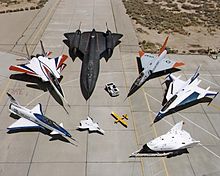
The forerunner of the fixed-wing aircraft is the kite. Whereas a fixed-wing aircraft relies on its forward speed to create airflow over the wings, a kite is tethered to the ground and relies on the wind blowing over its wings to provide lift. Kites were the first kind of aircraft to fly, and were invented in China around 500 BC. Much aerodynamic research was done with kites before test aircraft, wind tunnels, and computer modelling programs became available.
The first heavier-than-air craft capable of controlled free-flight were gliders. A glider designed by Cayley carried out the first true manned, controlled flight in 1853.
Practical, powered, fixed wing aircraft (the aeroplane or airplane) were invented by Wilbur and Orville Wright. Besides the method of propulsion, fixed-wing aircraft are in general characterized by their wing configuration. The most important wing characteristics are:
- Number of wings – Monoplane, biplane, etc.
- Wing support – Braced or cantilever, rigid, or flexible.
- Wing planform – including aspect ratio, angle of sweep, and any variations along the span (including the important class of delta wings).
- Location of the horizontal stabilizer, if any.
- Dihedral angle – positive, zero, or negative (anhedral).
A variable geometry aircraft can change its wing configuration during flight.
A flying wing has no fuselage, though it may have small blisters or pods. The opposite of this is a lifting body, which has no wings, though it may have small stabilizing and control surfaces.
Wing-in-ground-effect vehicles may be considered as fixed-wing aircraft. They "fly" efficiently close to the surface of the ground or water, like conventional aircraft during takeoff. An example is the Russian ekranoplan (nicknamed the "Caspian Sea Monster"). Man-powered aircraft also rely on ground effect to remain airborne with a minimal pilot power, but this is only because they are so underpowered — in fact, the airframe is capable of flying higher.
Rotorcraft
Rotorcraft, or rotary-wing aircraft, use a spinning rotor with aerofoil section blades (a rotary wing) to provide lift. Types include helicopters, autogyros, and various hybrids such as gyrodynes and compound rotorcraft.
Helicopters have a rotor turned by an engine-driven shaft. The rotor pushes air downward to create lift. By tilting the rotor forward, the downward flow is tilted backward, producing thrust for forward flight. Some helicopters have more than one rotor and a few have rotors turned by gas jets at the tips.
Autogyros have unpowered rotors, with a separate power plant to provide thrust. The rotor is tilted backward. As the autogyro moves forward, air blows upward across the rotor, making it spin. This spinning increases the speed of airflow over the rotor, to provide lift. Rotor kites are unpowered autogyros, which are towed to give them forward speed or tethered to a static anchor in high-wind for kited flight.
Compound rotorcraft have wings that provide some or all of the lift in forward flight. They are nowadays classified as powered lift types and not as rotorcraft. Tiltrotor aircraft (such as the V-22 Osprey), tiltwing, tailsitter, and coleopter aircraft have their rotors/ propellers horizontal for vertical flight and vertical for forward flight.
Other methods of lift
- A lifting body is an aircraft body shaped to produce lift. If there are any wings, they are too small to provide significant lift and are used only for stability and control. Lifting bodies are not efficient: they suffer from high drag, and must also travel at high speed to generate enough lift to fly. Many of the research prototypes, such as the Martin-Marietta X-24, which led up to the Space Shuttle, were lifting bodies (though the shuttle itself is not), and some supersonic missiles obtain lift from the airflow over a tubular body.
- Powered lift types rely on engine-derived lift for vertical takeoff and landing ( VTOL). Most types transition to fixed-wing lift for horizontal flight. Classes of powered lift types include VTOL jet aircraft (such as the Harrier jump-jet) and tiltrotors (such as the V-22 Osprey), among others.
Propulsion
Unpowered aircraft
Gliders are heavier-than-air aircraft that do not employ propulsion once airborne. Take-off may be by launching forward and downward from a high location, or by pulling into the air on a tow-line, either by a ground-based winch or vehicle, or by a powered "tug" aircraft. For a glider to maintain its forward air speed and lift, it must descend in relation to the air (but not necessarily in relation to the ground). Many gliders can 'soar' – gain height from updrafts such as thermal currents. The first practical, controllable example was designed and built by the British scientist and pioneer George Cayley, whom many recognise as the first aeronautical engineer. Common examples of gliders are sailplanes, hang gliders and paragliders.
Balloons drift with the wind, though normally the pilot can control the altitude, either by heating the air or by releasing ballast, giving some directional control (since the wind direction changes with altitude). A wing-shaped hybrid balloon can glide directionally when rising or falling; but a spherically shaped balloon does not have such directional control.
Kites are aircraft that are tethered to the ground or other object (fixed or mobile) that maintains tension in the tether or kite line; they rely on virtual or real wind blowing over and under them to generate lift and drag. Kytoons are balloon-kite hybrids that are shaped and tethered to obtain kiting deflections, and can be lighter-than-air, neutrally buoyant, or heavier-than-air.
Powered aircraft
Powered aircraft have one or more onboard sources of mechanical power, typically aircraft engines although rubber and manpower have also been used. Most aircraft engines are either lightweight piston engines or gas turbines. Engine fuel is stored in tanks, usually in the wings but larger aircraft also have additional fuel tanks in the fuselage.
Propeller aircraft
Propeller aircraft use one or more propellers (airscrews) to create thrust in a forward direction. The propeller is usually mounted in front of the power source in tractor configuration but can be mounted behind in pusher configuration. Variations of propeller layout include contra-rotating propellers and ducted fans.
Many kinds of power plant have been used to drive propellers. Early airships used man power or steam engines. The more practical internal combustion piston engine was used for virtually all fixed-wing aircraft until World War II and is still used in many smaller aircraft. Some types use turbine engines to drive a propeller in the form of a turboprop or propfan. Human-powered flight has been achieved, but has not become a practical means of transport. Unmanned aircraft and models have also used power sources such as electric motors and rubber bands.
Jet aircraft
Jet aircraft use airbreathing jet engines which take in air, burn fuel with it in a combustion chamber, and accelerate the exhaust rearwards to provide thrust.
Turbojet and turbofan engines use a spinning turbine to drive one or more fans, which provide additional thrust. An afterburner may be used to inject extra fuel into the hot exhaust, especially on military "fast jets". Use of a turbine is not absolutely necessary: other designs include the pulse jet and ramjet. These mechanically simple designs cannot work when stationary, so the aircraft must be launched to flying speed by some other method. Other variants have also been used, including the motorjet and hybrids such as the Pratt & Whitney J58, which can convert between turbojet and ramjet operation.
Compared to propellers, jet engines can provide much higher thrust, higher speeds and, above about 40,000 ft (12,000 m), greater efficiency. They are also much more fuel-efficient than rockets. As a consequence nearly all large, high-speed or high-altitude aircraft use jet engines.
Rotorcraft
Some rotorcraft, such as helicopters, have a powered rotary wing or rotor, where the rotor disc can be angled slightly forward so that a proportion of its lift is directed forwards. The rotor may, like a propeller, be powered by a variety of methods such as a piston engine or turbine. Experiments have also used jet nozzles at the rotor blade tips.
Other types of powered aircraft
- Rocket-powered aircraft have occasionally been experimented with, and the Messerschmitt Komet fighter even saw action in the Second World War. Since then, they have been restricted to research aircraft, such as the North American X-15, which traveled up into space where air-breathing engines cannot work (rockets carry their own oxidant). Rockets have more often been used as a supplement to the main power plant, typically for the rocket-assisted take off of heavily loaded aircraft, but also to provide high-speed dash capability in some hybrid designs such as the Saunders-Roe SR.53.
- The ornithopter obtains thrust by flapping its wings. It has found practical use in a model hawk used to freeze prey animals into stillness so that they can be captured, and in toy birds.
Design and construction
Aircraft are designed according to many factors such as customer and manufacturer demand, safety protocols and physical and economic constraints. For many types of aircraft the design process is regulated by national airworthiness authorities.
The key parts of an aircraft are generally divided into three categories:
- The structure comprises the main load-bearing elements and associated equipment.
- The propulsion system (if it is powered) comprises the power source and associated equipment, as described above.
- The avionics comprise the control, navigation and communication systems, usually electrical in nature.
Structure
The approach to structural design varies widely between different types of aircraft. Some, such as paragliders, comprise only flexible materials which act in tension and rely on aerodynamic pressure to hold their shape. A balloon similarly relies on internal gas pressure but may have a rigid basket or gondola slung below it to carry its payload. Early aircraft, including airships, often employed flexible doped aircraft fabric covering to give a reasonably smooth aeroshell stretched over a rigid frame. Later aircraft employed semi- monocoque techniques, where the skin of the aircraft is stiff enough to share much of the flight loads. In a true monocoque design there is no internal structure left.
The key structural parts of an aircraft depend on what type it is.
Aerostats
Lighter-than-air types are characterised by one or more gasbags, typically with a supporting structure of flexible cables or a rigid framework called its hull. Other elements such as engines or a gondola may also be attached to the supporting structure.
Aerodynes
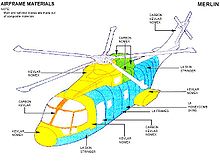
Heavier-than-air types are characterised by one or more wings and a central fuselage. The fuselage typically also carries a tail or empennage for stability and control, and an undercarriage for takeoff and landing. Engines may be located on the fuselage or wings. On a fixed-wign aircraft the wings are rigidly attached to the fuselage, while on a rotorcraft the wings are attached to a rotating vertical shaft. Smaller designs sometimes use flexible materials for part or all of the structure, held in place either by a rigid frame or by air pressure. The fixed parts of the structure comprise the airframe.
Avionics
The avionics comprise the flight control systems and related equipment, including the cockpit instrumentation, navigation, radar, monitoring, and communication systems.
Flight characteristics
Flight envelope
The flight envelope of an aircraft refers to its capabilities in terms of airspeed and load factor or altitude. The term can also refer to other measurements such as maneuverability. When a craft is pushed, for instance by diving it at high speeds, it is said to be flown "outside the envelope", something considered unsafe.
Range

The range is the distance an aircraft can fly between takeoff and landing, as limited by the time it can remain airborne.
For a powered aircraft the time limit is determined by the fuel load and rate of consumption.
For an unpowered aircraft, the maximum flight time is limited by factors such as weather conditions and pilot endurance. Many aircraft types are restricted to daylight hours, while balloons are limited by their supply of lifting gas. The range can be seen as the average ground speed multiplied by the maximum time in the air.
Flight dynamics
Flight dynamics is the science of air vehicle orientation and control in three dimensions. The three critical flight dynamics parameters are the angles of rotation around three axes about the vehicle's centre of mass, known as pitch, roll, and yaw (quite different from their use as Tait-Bryan angles).
- Roll is a rotation about the longitudinal axis (equivalent to the rolling or heeling of a ship) giving an up-down movement of the wing tips measured by the roll or bank angle.
- Pitch is a rotation about the sideways horizontal axis giving an up-down movement of the aircraft nose measured by the angle of attack.
- Yaw is a rotation about the vertical axis giving a side-to-side movement of the nose known as sideslip.
Flight dynamics is concerned with the stability and control of an aircraft's rotation about each of these axes.
Stability

An aircraft which is unstable tends to diverge from its current flight path and so is difficult to fly. An aircraft which is very stable tends to stay on its current flight path and is difficult to manoeuvre. So it is important for any design to achieve the desired degree of stability. Since the widespread use of digital computers, it is becoming increasingly common for designs to be inherently unstable and to rely on computerised control systems to provide artifical stability.
A fixed wing is typically unstable in pitch and yaw, so conventional fixed wing designs need horizontal and vertical stabilisers which act in a similar way to the feathers on an arrow. These stabilizing surfaces allow equilibrium of aerodynamic forces and to stabilise the flight dynamics of pitch and yaw. They are usually mounted on the tail section ( empennage), though the canard configuration has a foreplane, in front of the main wing, which may sometimes act as the horizontal stabilizer. Tailless aircraft rely on other techniques to achieve stability.
A rotary wing is typically unstable in yaw, requiring a vertical stabiliser.
A balloon is typically very stable in pitch and roll due to the way the payload is hung underneath.
Control
Flight control surfaces enable the pilot to control an aircraft's flight attitude and are usually part of the wing or mounted on, or integral with, the associated stabilizing surface. Their development was a critical advance in the history of aircraft, which had until that point been uncontrollable in flight.
Aerospace engineers develop control systems for a vehicle's orientation (attitude) about its centre of mass. The control systems include actuators, which exert forces in various directions, and generate rotational forces or moments about the aerodynamic centre of the aircraft, and thus rotate the aircraft in pitch, roll, or yaw. For example, a pitching moment is a vertical force applied at a distance forward or aft from the aerodynamic centre of the aircraft, causing the aircraft to pitch up or down. Control systems are also sometimes used to increase or decrease drag, for example to slow the aircraft to a safe speed for landing.
The two main aerodynamic forces acting on any aircraft are lift supporting it in the air and drag opposing its motion. Control surfaces or other techniques may also be used to affect these forces directly, without inducing any rotation.
Impact and use
In general, aircraft have positive properties as they permit long distance, high speed travel and are often reasonably efficient. In addition to their usefulness, they have some environmental impacts. They generate some atmospheric pollution, are relatively noisy compared to other forms of travel and high altitude aircraft generate contrails which experimental evidence suggests may alter weather patterns.
Aircraft are produced in several different types optimized for various uses; military aircraft, which includes not just combat types but many types of supporting aircraft, and civil aircraft, which include all non-military types, experimental and model.
Military
A military aircraft is any aircraft that is operated by a legal or insurrectionary armed service of any type. Military aircraft can be either combat or non-combat:
- Combat aircraft are aircraft designed to destroy enemy equipment using its own armament. Combat aircraft divide broadly into fighters and bombers, with several in-between types such as fighter-bombers and ground-attack aircraft (including attack helicopters).
- Non-Combat aircraft are not designed for combat as their primary function, but may carry weapons for self-defense. Non-combat roles include search and rescue, reconnaissance, observation, transport, training, and aerial refueling. These aircraft are often variants of civil aircraft such as the Douglas DC-3 airliner.
The vast majority of military aircraft are powered heavier-than-air types. Other types such as Gliders and balloons have also been used as military aircraft; for example, balloons were used for observation during the American Civil War and World War I, and military gliders were used during World War II to land troops.
Civil
Civil aircraft divide into commercial and general types, however there are some overlaps.
Commercial aircraft include types designed for scheduled and charter airline flights, carrying passengers, mail and other cargo. The larger passenger-carrying types are the airliners, the largest of which are wide-body aircraft. Some of the smaller types are also used in general aviation, and some of the larger types are used as VIP aircraft.
General aviation is a catch-all covering other kinds of private (where the pilot is not paid for time or expenses) and commercial use, and involving a wide range of aircraft types such as business jets (bizjets), trainers, homebuilt, gliders, warbirds and hot air balloons to name a few. The vast majority of aircraft today are general aviation types.
Experimental
An experimental aircraft is one that has not been fully proven in flight, or one that carries an FAA airworthiness certificate in the "Experimental" category. Often, this implies that new aerospace technologies are being tested on the aircraft, although the term also refers to amateur- and kit-built aircraft; many of which are based on proven designs.
Model
A model aircraft is a small unmanned type made to fly for fun, for static display, for aerodynamic research or for other purposes. A scale model is a replica of some larger design.


